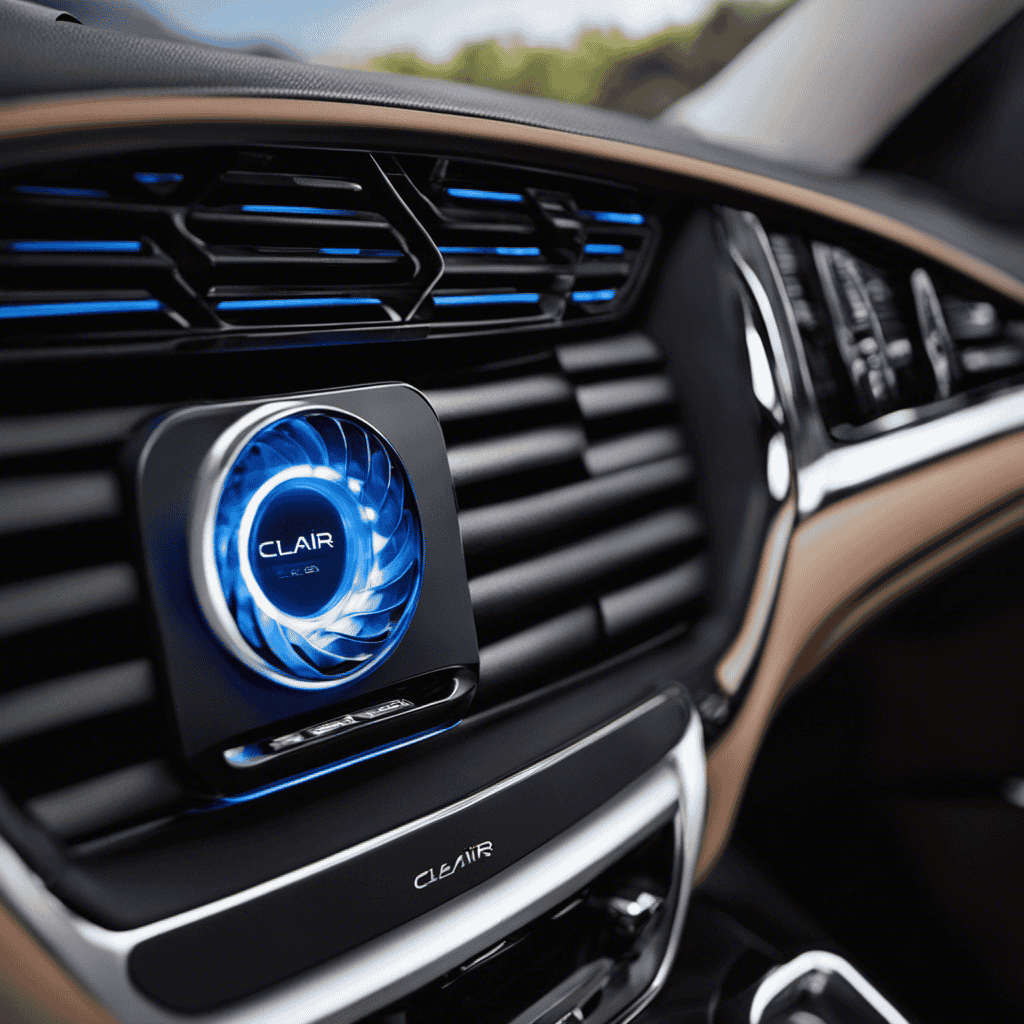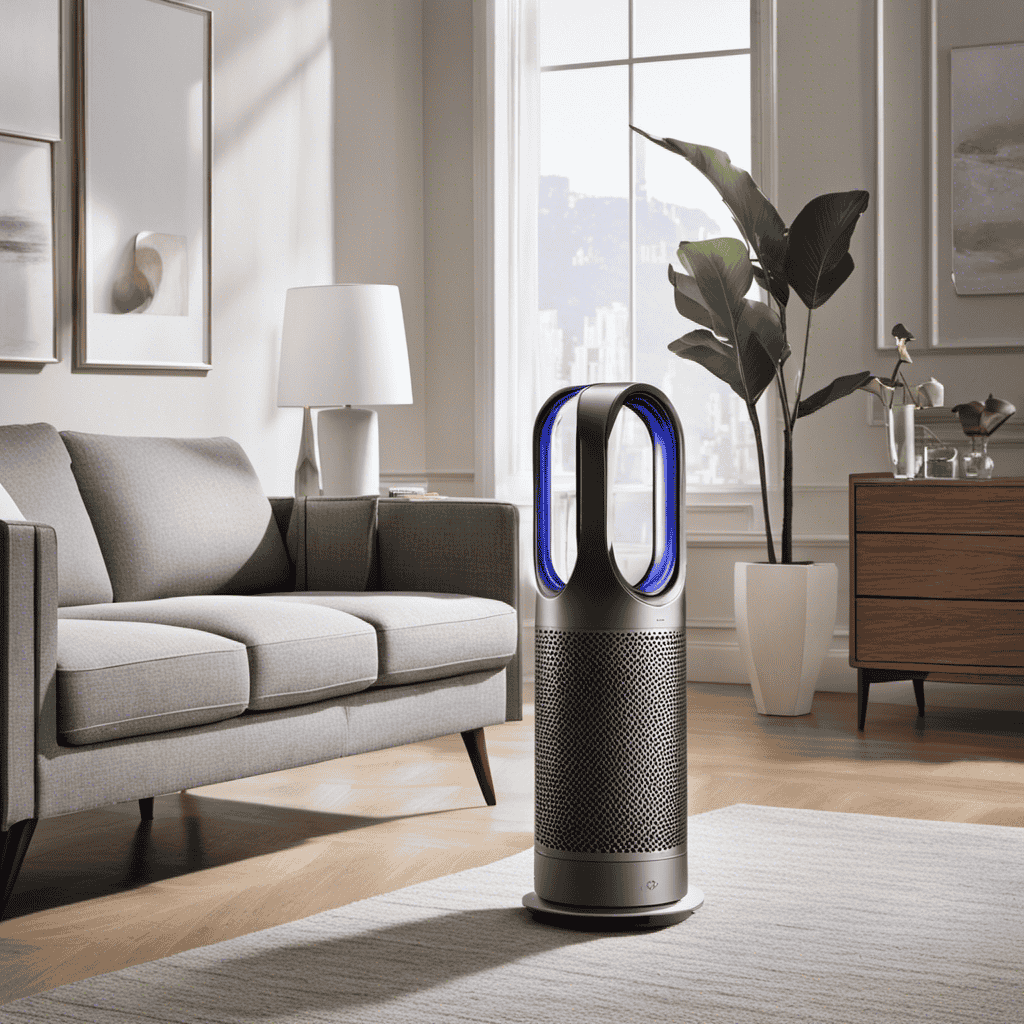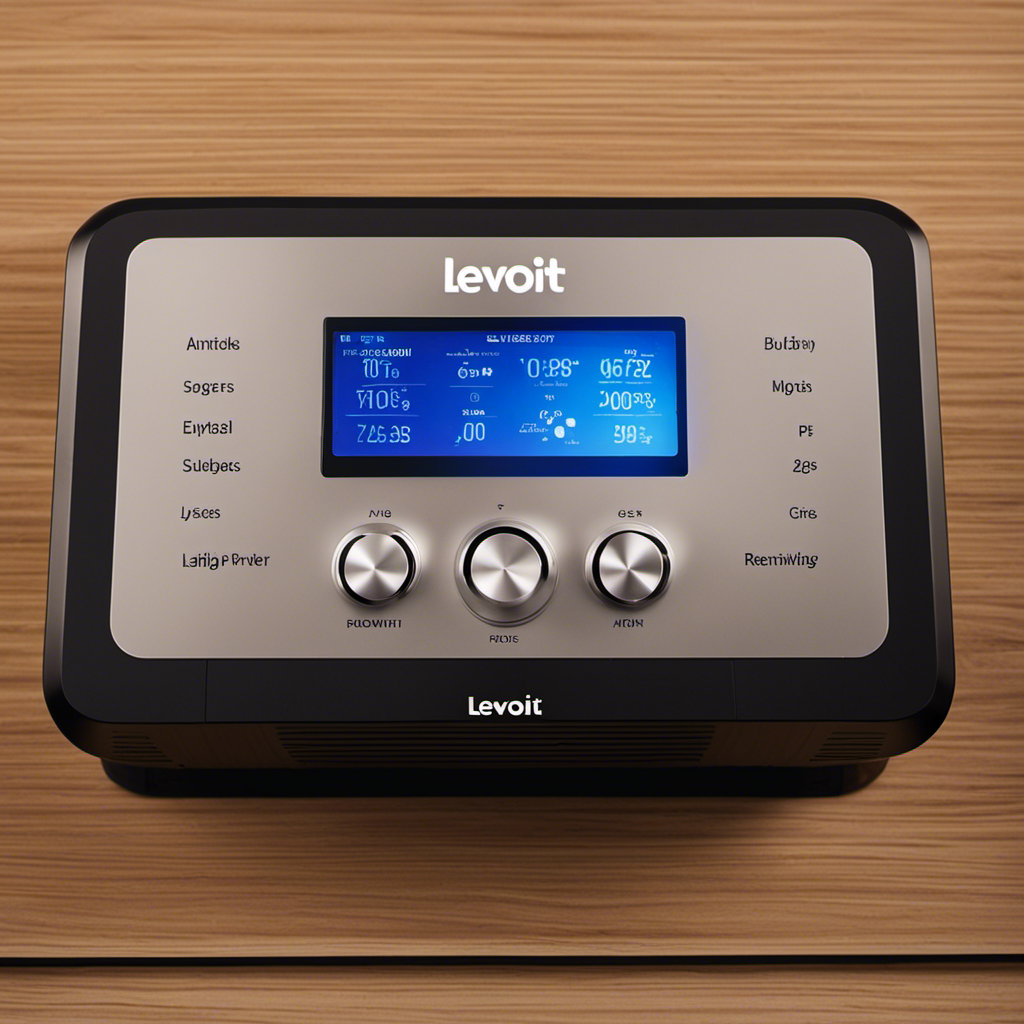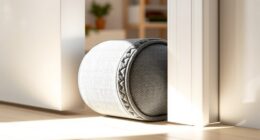Ever thought about how frequently you should replace your air purifier filter? I’m here to give you all the necessary information.
In this article, we will explore the different types of air purifier filters, the factors that affect their lifespan, and the recommended frequency for changing them.
We will also discuss the signs that indicate your filter needs replacement, as well as the steps to replace it properly.
So, let’s dive in and discover the benefits of regular filter changes and eco-friendly options for replacement.
Key Takeaways
- Regularly changing air purifier filters is essential for maintaining clean and healthy indoor air quality.
- Different types of air purifier filters have varying lifespans, so understanding filter replacement frequency is crucial for optimal performance.
- Factors affecting filter lifespan include air quality, usage, filter type, contaminant capture, and manufacturer’s recommendations.
- Cleaning air purifier filters can be a cost-effective option, but it may not be as effective as replacing the filter entirely.
Understanding Air Purifier Filters
Air purifier filters are an essential component of maintaining clean and healthy indoor air quality. They play a critical role in removing various types of air pollutants, such as dust, pollen, pet dander, and even harmful volatile organic compounds (VOCs) from the air we breathe. These filters are designed to trap and capture these pollutants, preventing them from circulating back into the air.
This is especially important because clean air is vital for our overall well-being. Breathing in polluted air can lead to respiratory issues, allergies, and even long-term health problems. By regularly changing and maintaining air purifier filters, we can ensure that the air we breathe is free from harmful pollutants, promoting a healthier indoor environment for ourselves and our loved ones.
Types of Air Purifier Filters
When it comes to air purifiers, understanding the frequency at which filters need to be replaced is crucial. In this discussion, I will explore the recommended filter replacement frequency for different types of air purifiers, backed by evidence-based research.
Additionally, I will compare the effectiveness of various filters in removing pollutants from the air and highlight the advantages and disadvantages of different filter technologies available in the market today.
Filter Replacement Frequency
The recommended frequency for replacing the air purifier filter depends on factors such as usage and air quality. To ensure optimal performance and clean air, it’s important to follow a filter replacement schedule.
Here are three key factors to consider when determining how often to replace your air purifier filter:
-
Usage: If you use your air purifier for several hours every day, the filter may need to be replaced more frequently. High usage can lead to a quicker buildup of contaminants and reduce the lifespan of the filter.
-
Air Quality: If you live in an area with poor air quality or have specific concerns such as allergies or asthma, you may need to replace the filter more often. Polluted environments can clog the filter faster, reducing its effectiveness.
-
Extending Filter Lifespan: Regular maintenance, such as vacuuming or washing the pre-filter, can help extend the lifespan of the main filter. Following manufacturer guidelines and replacing the filter when recommended is crucial for optimal performance and clean air.
Filter Effectiveness Comparison
To determine which filter is most effective for you, consider factors such as your specific needs and the level of contaminants in your environment. It’s important to compare filter lifespans to ensure you are getting the best value for your money. Some filters may need to be replaced more frequently, while others can last longer.
Additionally, proper filter maintenance is crucial to ensure optimal performance. Here are some tips to keep in mind:
- First, follow the manufacturer’s recommendations for filter replacement.
- Second, regularly clean or replace pre-filters to prolong the lifespan of the main filter.
- Third, avoid placing the air purifier in dusty areas to prevent clogging and reduce the strain on the filter.
Different Filter Technologies
Different filter technologies have varying levels of effectiveness in removing contaminants from the air. When it comes to air purifiers, understanding the different filter technologies can help you make an informed decision about which one is best for your needs. Here are three common filter technologies and their effectiveness in removing airborne pollutants:
-
HEPA Filters: Highly effective in removing particles as small as 0.3 microns, including dust, pollen, pet dander, and mold spores.
-
Activated Carbon Filters: Excellent at removing odors, gases, and volatile organic compounds (VOCs) from the air.
-
UV-C Filters: Utilize ultraviolet light to kill bacteria, viruses, and other microorganisms.
To ensure the effectiveness of your air purifier, regular filter maintenance is crucial. Factors such as the quality of the filter material, the amount of pollutants in the air, and the frequency of use can all affect the lifespan of the filter. Proper care and timely replacement are essential to maintain optimal performance and clean indoor air.
In the next section, we will explore in more detail the factors that can affect the lifespan of air purifier filters.
Factors Affecting Filter Lifespan
When it comes to the lifespan of air purifier filters, there are two important factors to consider: usage and environmental impact, as well as proper maintenance practices.
The way we use our air purifiers, such as the frequency and duration of operation, can greatly affect the lifespan of the filters. Additionally, the quality of the air and the presence of pollutants in the environment can also impact filter lifespan.
Lastly, following proper maintenance practices, such as regular cleaning and replacement of filters, can help prolong their lifespan and ensure optimal performance.
Usage and Environment Impact
The usage and environment impact of air purifier filters can vary depending on factors such as air quality and the frequency of use. Here are three important points to consider when it comes to the impact of air purifier filters:
-
Eco-friendly alternatives: Some air purifier filters are made from materials that are harmful to the environment. However, there are eco-friendly alternatives available, such as filters made from activated carbon or bamboo charcoal. These filters are not only effective at removing pollutants from the air but also have a lower environmental impact.
-
Impact on indoor air quality: Air purifier filters play a crucial role in improving indoor air quality. They help remove harmful particles such as dust, pollen, pet dander, and smoke from the air, making it cleaner and healthier to breathe. Regularly changing the filters ensures that the air purifier continues to effectively remove these pollutants.
-
Frequency of filter changes: The frequency at which you need to change your air purifier filters depends on factors such as the manufacturer’s recommendations, the level of air pollution in your area, and the usage of the purifier. It is important to follow the manufacturer’s guidelines and monitor the filter’s condition regularly to ensure optimal performance.
Proper Maintenance Practices
One way to ensure optimal performance is by regularly monitoring and maintaining the condition of your air purifier’s filters. Filters play a crucial role in removing pollutants from the air, but they can become clogged over time, reducing their effectiveness.
To avoid this, it is important to know the signs that indicate a filter replacement is needed. One common sign is reduced airflow, which can indicate a clogged filter. Another sign is an increase in allergy symptoms or respiratory issues, as this may indicate that the filter is no longer effectively capturing allergens and contaminants. Additionally, if you notice a persistent odor in your home, it could be a sign that the filter needs to be replaced.
By paying attention to these signs, you can ensure that your air purifier is always working at its best.
Now, let’s discuss the recommended filter change frequency.
Recommended Filter Change Frequency
It’s important to regularly change your air purifier filter to ensure its optimal performance. The lifespan of an air purifier filter can vary depending on several factors. Here are three key factors that can affect the performance and lifespan of your air purifier filter:
-
Air quality: If you live in an area with high levels of pollutants and allergens, your air purifier filter may need to be changed more frequently. The more contaminants it captures, the quicker it will become clogged and less effective.
-
Usage: The more often you use your air purifier, the more frequently you should change the filter. If you run your purifier constantly or in rooms with high traffic, the filter will accumulate more particles and require more frequent replacement.
-
Filter type: Different types of air purifier filters have varying lifespans. HEPA filters, for example, are known for their long lifespan and can last up to a year with regular maintenance. On the other hand, carbon filters may need to be replaced more frequently, typically every 3-6 months.
Signs Your Air Purifier Filter Needs Replacement
If you notice a decrease in air quality and an increase in allergies or respiratory issues, you may need to replace your air purifier filter. Knowing when to clean or replace your filter is essential for maintaining optimal air quality in your home.
Most air purifiers come with filter replacement indicators, which are designed to let you know when it’s time for a change. These indicators may be in the form of lights or digital displays that show the filter’s remaining life. Additionally, some filters have a recommended replacement frequency, usually ranging from every three to six months.
Regularly checking your filter and following the manufacturer’s recommendations will ensure that your air purifier continues to function effectively. Proper maintenance for longer filter life includes regular cleaning and vacuuming to remove dust and debris, as well as avoiding placing the purifier in areas with excessive humidity or smoke.
Proper Maintenance for Longer Filter Life
When it comes to maintaining my air purifier, I often find myself wondering about the frequency of filter replacement and whether cleaning them is sufficient. To address these concerns, I have delved into research and found some evidence-based insights.
Understanding the recommended filter replacement frequency and weighing the benefits of cleaning versus replacing can help ensure that my air purifier remains effective in providing clean and healthy air.
Filter Replacement Frequency
The recommended frequency for changing the air purifier filter is typically every six to twelve months. However, this can vary depending on several factors.
To determine the filter lifespan and create a proper filter replacement schedule, consider the following:
-
Manufacturer’s recommendation: Check the air purifier’s user manual or contact the manufacturer to find out their specific recommendations for filter replacement frequency.
-
Indoor air quality: If you live in an area with high pollution levels or have pets or smokers in your home, the filter may need to be replaced more frequently.
-
Filter efficiency: Different filters have different lifespans. HEPA filters, for example, tend to last longer than activated carbon filters. Consider the type of filter you have and its efficiency when determining the replacement schedule.
Cleaning Vs. Replacing?
In terms of cleaning methods, some air purifier filters can be cleaned instead of replaced. However, this depends on the type of filter and the manufacturer’s instructions.
For example, some filters can be vacuumed or rinsed with water to remove the accumulated dirt and debris. This can be a cost-effective option as it eliminates the need to purchase new filters regularly. However, it is important to note that cleaning may not be as effective as replacing the filter entirely. Over time, the filter’s efficiency can degrade, reducing its ability to remove pollutants from the air.
Additionally, some filters are not designed to be cleaned and may become damaged if subjected to cleaning methods. Therefore, it is essential to check the manufacturer’s recommendations before attempting to clean an air purifier filter.
Extending the Lifespan of Your Air Purifier Filter
By regularly cleaning and maintaining your air purifier filter, you can extend its lifespan. Here are some filter maintenance techniques that can help you keep your air purifier filter in optimal condition:
-
Vacuum the filter: Gently vacuuming the filter can remove large particles and debris, improving its efficiency and prolonging its lifespan.
-
Wash the filter: Some air purifier filters are washable. Follow the manufacturer’s instructions and use mild soap and water to clean the filter. Make sure to let it dry completely before reinstalling it.
-
Replace the filter when necessary: Despite regular cleaning, filters will eventually reach their limit. Check the manufacturer’s recommendations for the specific lifespan of your filter and replace it accordingly.
By following these maintenance techniques, you can significantly increase the lifespan of your air purifier filter and ensure it continues to provide clean and fresh air for you and your family.
Now, let’s move on to the next section, where we will discuss how to replace an air purifier filter.
How to Replace an Air Purifier Filter
Now it’s time to show you how easy it is to swap out your old filter for a new one.
When it comes to choosing the right air purifier filter, there are a few factors to consider. First, determine the size and type of filter your air purifier requires. Look for filters that are compatible with your specific model and have the right level of filtration for your needs.
Next, consider the lifespan and replacement frequency of the filter. Some filters may need to be replaced every 3 months, while others can last up to a year.
As for where to buy air purifier filters, you have several options. You can purchase them directly from the manufacturer, online retailers, or local stores that specialize in air purifiers and filters. Remember to check for any warranty or return policies before making a purchase.
With these tips in mind, replacing your air purifier filter should be a breeze.
Benefits of Regular Filter Changes
Regularly changing your filter can improve air quality and reduce the amount of dust and allergens in your home. Here are three benefits of clean air and maintaining the lifespan of your filter:
-
Improved Respiratory Health: Clean air means fewer irritants and pollutants in your home, which can help reduce respiratory issues such as allergies, asthma, and bronchitis.
-
Enhanced Sleep Quality: Breathing in clean air while you sleep can improve the quality of your rest. It can reduce snoring, congestion, and help you wake up feeling refreshed.
-
Increased Energy Levels: When your indoor air is clean, you may experience higher energy levels throughout the day. This is because your body doesn’t have to work as hard to filter out harmful particles, allowing you to focus on other activities.
Common Mistakes to Avoid When Changing Air Purifier Filters
When changing air purifier filters, it’s important to avoid common mistakes that could compromise the effectiveness of the filtration system. One common mistake is not properly installing the new filter. It’s crucial to follow the manufacturer’s instructions and ensure that the filter is securely in place.
Another mistake is not replacing the filter at the recommended intervals. Over time, filters become clogged with dust, allergens, and other particles, reducing their efficiency. By neglecting to change the filter regularly, the air purifier may not effectively remove pollutants from the air.
Additionally, some people make the mistake of using the wrong type of filter for their specific air purifier model. It’s essential to research and purchase the correct filter to ensure optimal performance.
By avoiding these common mistakes, you can ensure your air purifier functions at its best, providing you with clean and healthy indoor air.
Now, let’s explore some eco-friendly options for air purifier filter replacement.
Eco-Friendly Options for Air Purifier Filter Replacement
Using eco-friendly filters for your air purifier replacement is a great way to reduce your environmental impact. Not only do these filters help clean the air in your home, but they also minimize waste and support sustainable practices.
Here are three eco-friendly filter options to consider:
-
Washable Filters: These filters are designed to be reusable, saving you money in the long run. Simply remove the filter, wash it with water and mild detergent, and let it air dry before reinserting it into your air purifier.
-
Activated Carbon Filters: Made from natural materials like coconut shells, activated carbon filters are highly effective at trapping and removing odors, chemicals, and volatile organic compounds (VOCs) from the air. They can be disposed of in an organic waste bin or composted.
-
DIY Filter Replacements: Instead of buying a pre-made filter, you can make your own using materials like activated carbon, non-toxic glue, and a reusable frame. This option allows you to customize the filter to your specific needs and reduces waste from packaging.
Frequently Asked Questions
Can I Clean and Reuse My Air Purifier Filter Instead of Replacing It?
I don’t recommend cleaning and reusing my air purifier filter. Replacing it is more effective in maintaining air quality and preventing allergens. Additionally, reusable filters may not provide the same level of filtration.
How Do I Know if My Air Purifier Filter Is Still Effective?
I can tell if my air purifier filter is still effective by looking for signs of dirtiness, such as a visible layer of dust or a decrease in air flow. As for how often to replace it, it depends on the manufacturer’s recommendations.
Are There Any DIY Methods to Extend the Lifespan of My Air Purifier Filter?
There are DIY methods to maintain an air purifier filter, such as vacuuming it regularly and keeping it away from dust and debris. Regular filter replacement has benefits like improved air quality.
Can I Use a Different Brand or Type of Filter in My Air Purifier?
I wouldn’t recommend using a different brand or type of filter in your air purifier. Stick with HEPA filters as they provide the best benefits for air quality and ensure the longevity of your purifier.
Are There Any Health Risks Associated With Not Changing the Air Purifier Filter Regularly?
Neglecting air purifier maintenance by not changing the filter regularly can pose health risks. Using a dirty filter reduces its effectiveness in removing pollutants, leading to poor indoor air quality and potential respiratory issues.
Conclusion
In conclusion, the air purifier filter is like a shield that protects us from the invisible invaders in our homes. It silently battles against dust, allergens, and pollutants, ensuring that we breathe clean and fresh air.
Just like a knight needs a new armor to keep fighting, our air purifier filter needs to be changed regularly. By doing so, we are not only ensuring our health and well-being but also extending the life of our beloved air purifier.
So, let’s embrace this symbol of purity and make a habit of changing our air purifier filters regularly.










